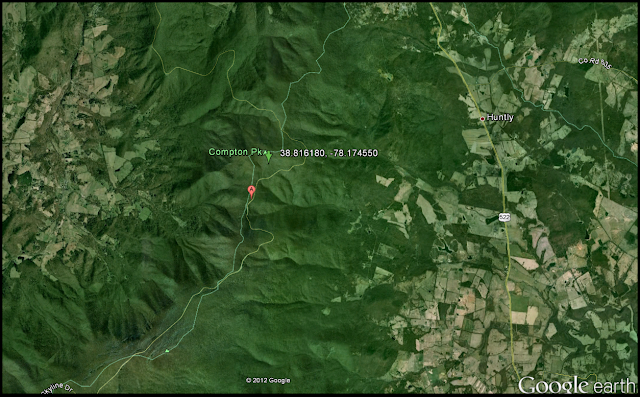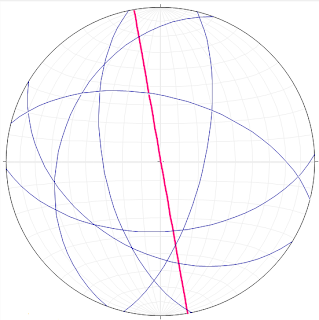A
few weeks ago my structural geology class went on a four mile hike near a break
in Bull Run Mountain known as Thoroughfare Gap (TFG). This area marks the
beginning of the Blue Ridge Mountain range and the end of the Piedmont. Between these two
ancient mountain belts lay the Culpeper Mesozoic Basin. The day's mission was to take strike and dip measurements of joint sets, veins, and other deformations due to Appalachian Mountain building. Then, from these
measurements, determine the orientation of the applied stress. This will be determined
from a collection of the class’s data along with stereo-net software.
Important to note: although there was no history lesson given in the sequence of this trip, during the American Civil War, in 1862, this was the location of the Battle of Thoroughfare Gap.
As an
added benefit the class walked the railroad tracks that bisect the gap and came
across a Jurassic aged outcrop known as the Waterfall Conglomerate. The large
rocks contained in this loosely cemented outcrop are from the Valley and Ridge
Province to the west in the Shenandoah Valley. The fascinating idea here is
that they were once at the bottom, or the bed load, of a river and are only found in the Culpeper basin (USGS, 2003). The presence of the conglomerate and the gap in Broad Run are indicative of a once high velocity river that, due to its incising, was there before the mountains! Below are pictures taken of the Waterfall Conglomerate on TFG.
 |
| Pictures taken of the Waterfall Conglomerate. Note the subangular clast sizes and the reddish brown matrix. Picture taken by Jodi Deprizio |
The
day started out at 10:00 am at the back of the loading docks at George Mason
University in Fairfax. After the usual paperwork – insurance forms –
the class embarked on their journey to Thoroughfare Gap. The day was cloudy
with a high of 63 °F with a eesmall chance of
rain – 10%. Thankfully, I don’t trust meteorologist and brought my rain gear anyway
– this was a good call. It started to drizzle around lunch time when we finally
got to the peak and soon thereafter the temperatures dropped. However, due to the absolutely magnificent
view at the top of Bull Run Mountain, overlooking the Culpeper Basin towards
the Blue Ridge Anticlinorium, the class didn’t seem to notice the rain.
 |
| The view at the top of Bull Run Mountain looking out across the Culpeper Mesozoic Basin. The Blue Ridge Anticlinorium visible in the distance. |
The Chilhowee Group is made up of the Weverton, Harpers, and Antietam Formations respectively. The group originated from one, extremely slow, geological event - erosion of the proto-Appalachian Mountains. The driving force of this erosional event was the Grenville orogeny and the making of Rodinia, which caused the proto-Appalachians to be uplifted. Rodinia's creation and the resulting collisions with North America and parts of South America resulted in the Grenville Range. It is common for areas of former crustal spreading to become areas of new crustal spreading because of weakness that already exist in the crust. Much like the way water prefers rock that has already been fragmented, which was discussed in earlier posts regarding Mather Gorge.
The rifting of Rodinia, roughly 700 Mya, allowed for basalt/magma to be 'squirt' or inserted into newly opened joints and faults. Later, this basalt deposit became the bottom of the Iapetus Ocean. The rifting continued, and eroded sediments from the proto-Appalachian Mountains were deposited on the bottom of the new ocean ultimately creating the three formations. The term used for this by geologist and coastal scientists is passive margin sedimentation, more simply put the transition between oceanic and continental crust. Continental rifting creates new ocean basins, as was happening with the Iapetus Ocean, and as this progresses the ocean basin or floor becomes wider. Remember that basalt is being injected or 'squirt' into areas as the crust is being spread apart. As the extension continues a mid-oceanic ridge forms and this transition between oceanic (basalt) and continental crust, that was originally created, is called the passive margin.
The second tectonic event of interest in this area is the assembly and separation of Pangaea roughly 290 Mya. The making of Pangaea and the closing of the Iapetus Ocean marked the beginning of the Appalachian orogenies. The Appalachian Mountains were formed from many collisions, specifically the Alleghanian/Appalachian orogenies. These were caused by the collision of North America and Africa. At this time Africa was part of a larger continent called Gondwanaland. This event created the much larger, super-continent of Pangaea. Due to the ever changing world another rifting event was initiated, which would eventually form the coast of eastern North America and western Africa as well as the Atlantic Ocean. The separation of the last super-continent.
The break-up of this ancient super-continent resulted in a series of normal fault basins or grabens, which through progressive spreading, became the bottom of the Atlantic Ocean. As discussed before, this spreading allows for magma to be injected or squirt into joints and fractures eventually creating an oceanic basin or chasm. However, not all areas of spreading fulfill a full rifting sequence. The Culpeper Basin is one such failed geologic event. Initially, for spreading to occur, there must be three points of rifting also known as the triple junction above a hotspot. In the case of the Culpeper Basin two of the three points of rifting failed and one continued. Due to the failure of the Culpeper Basin, which is associated with a much larger aulocogen called the Newark Supergroup, Fairfax County is located on the east coast of America and not on the west coast of Africa. Please note diagrams below that illustrate processes for development of Chilhowee Group.
 |
| 'Ancient Lands' depicts the ancient mountains stretching from Bull Run Mountain to Front Royal. Please note the chronological order of the topographical sequences in the right top corner. Picture from brmconservancy.org. |
 |
| Culpeper Mesozoic Basin Diagram of processes associated with the creation of the Chilhowee Group. Rifting as well as the beginning of an ocean basin. Picture courtesy C.M. Bailey. |
As
the class started the first two miles up Bull Run Mountain our guide, Aaron
Barth a former structural geology student, pointed out sections of the Weverton Formation,
and made note that they were dipping off to the east. The Weverton layer was the first to be deposited during the rifting of Rodinia. The phyllitic Harpers Formation, also dipping to the east, was noted along the hike which may have been a lagoon during the making of the Iapetus Ocean. The term phyllitic refers to one of the main types of continuous cleavage and more specifically has larger sized grains and a soft pearly luster. Geologist use the term cleavage to represent a plan in a rock that allows for splitting, more simply put if a rock were hit by a hammer the break would occur along its cleavage. A picture of the Harpers Formation is below, the second layer of the Chilhowee Group.
 |
Picture of exposed Harper Formation taken at the beginning of the Thoroughfare Gap Hike. Please note the location map on the side of the picture for better oversight of topography and locality.
|
After the wonderful view and lunch break the class proceeded onto the next adventure, which consisted of the measuring of joint sets, veins and deformed bedding. This is, hopefully, going to tell us in what orientation the stress was coming from. Below is a picture of the railroad along which Thoroughfare Gap is outcropped.
 |
| Thoroughfare Gap. The railroad tracks (left) and a float rock from the Blue Ridge Basin Province (right) note the blue quartz and how it has been lineated. |
 |
| Areas of significance while out in the field. There is more than one joint set present and, because of this it resembles a synform. The yellow, red, and black lines represent different joint sets. |
It is now time to answer the question of force/stress orientation by using what is known about the geological history and stereo-net software.
 |
The arrows are point to possible clusters of joints, or joint sets obtained using
stereo-net software. |
There appears to be at least two, possibly three, sets of joints in this outcrop. As seen in the pictures above, some joints don't extend past others that are in a perpendicular to one another. There also seems to be a ~45 degree angle between the longer black joint and the yellow joint set.
 |
| Bedding orientations at TFG which seem to be in a non-horizontal position. |
The bedding planes seem to be in an altered position from original deposition and somewhat parallel to the joint sets. There is also more than one geological event associated with a bedding plane. This area marks the beginning of the Blue Ridge 'overturned' anticlinorium.
 |
Quartz vein orientations at TFG. Please note the striking similarity to the
bedding planes. |
The quartz veins are very similar in orientation to the bedding planes. . . At this time I cannot explain this, however, will be trying to piece this together in the mean time. I would have expected the joint sets and the quartz veins to line up, not the bedding planes. It is possible, however, to achieve this and that is by foliation. It is also important to note that cleavage will form perpendicular to the direction of greatest shortening and all foliation is cleavage but not all cleavage is foliation.
Thus to answer the question, first referenced above, regarding the stress orientations applied to the strata - The longest axis is parallel to the fold axis - which would account for the placement of the quartz veins - the idea is that when the strata was folding the inside was crumpled or pulverized together while the outer part of the fold was pulled apart allowing for pressure solution and precipitates.


































